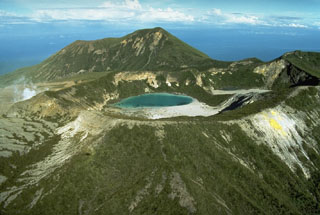Report on Balbi (Papua New Guinea) — October 1984
Scientific Event Alert Network Bulletin, vol. 9, no. 10 (October 1984)
Managing Editor: Lindsay McClelland.
Balbi (Papua New Guinea) Boiling mud, active fumaroles and solfataras
Please cite this report as:
Global Volcanism Program, 1984. Report on Balbi (Papua New Guinea) (McClelland, L., ed.). Scientific Event Alert Network Bulletin, 9:10. Smithsonian Institution. https://doi.org/10.5479/si.GVP.SEAN198410-255010
Balbi
Papua New Guinea
5.9156°S, 155.0008°E; summit elev. 2715 m
All times are local (unless otherwise noted)
Balbi, Bougainville's highest point, is in the N-central part of the island on the axial volcanic chain. In [what is possibly an eroded caldera at the summit of the composite cone, seven craters] lie on a N-S ridge about 3 km long. [There are also two cones about 2 km W of the line of craters.] Only Crater B, about 600 m in diameter and second from the S, shows activity. Anthropological evidence suggests an explosive eruption accompanied by nuées ardentes and fatalities, sometime between 1800 and 1850 [but recent geological work does not support this.]
"A boiling mud pool and up to a dozen large, very active fumaroles flanked the lineament of craters. Large collapses have occured into Crater B, and further extensive tension cracks were visible around the crater's rim. Many small solfataras were still active in the W wall of Crater B. The lake in Crater C had diminished in size." [Recent RVO investigations show that the fumaroles are aligned orthogonally to the 7-crater lineament and that the mud pool is no longer active.]
Geological Summary. The complex andesitic Balbi stratovolcano on Bougainville Island includes a large number of coalesced cones and lava domes. Five well-preserved craters occupy a NW-SE-trending ridge north of the summit cone, which also contains a crater. Three large valleys with steep headwalls dissect the flanks. The age of the most recent eruption is not known precisely. An oral tradition of a major eruption during the 19th century is thought to be in error, but could refer to minor eruptive activity. Fumaroles are located within 600-m-wide Crater B and on its W flank.
Information Contacts: K. McCue, Bougainville Copper Ltd., Panguna [with January 1988 additions from RVO].

